Jackson M.J. Micro and Nanomanufacturing
Подождите немного. Документ загружается.

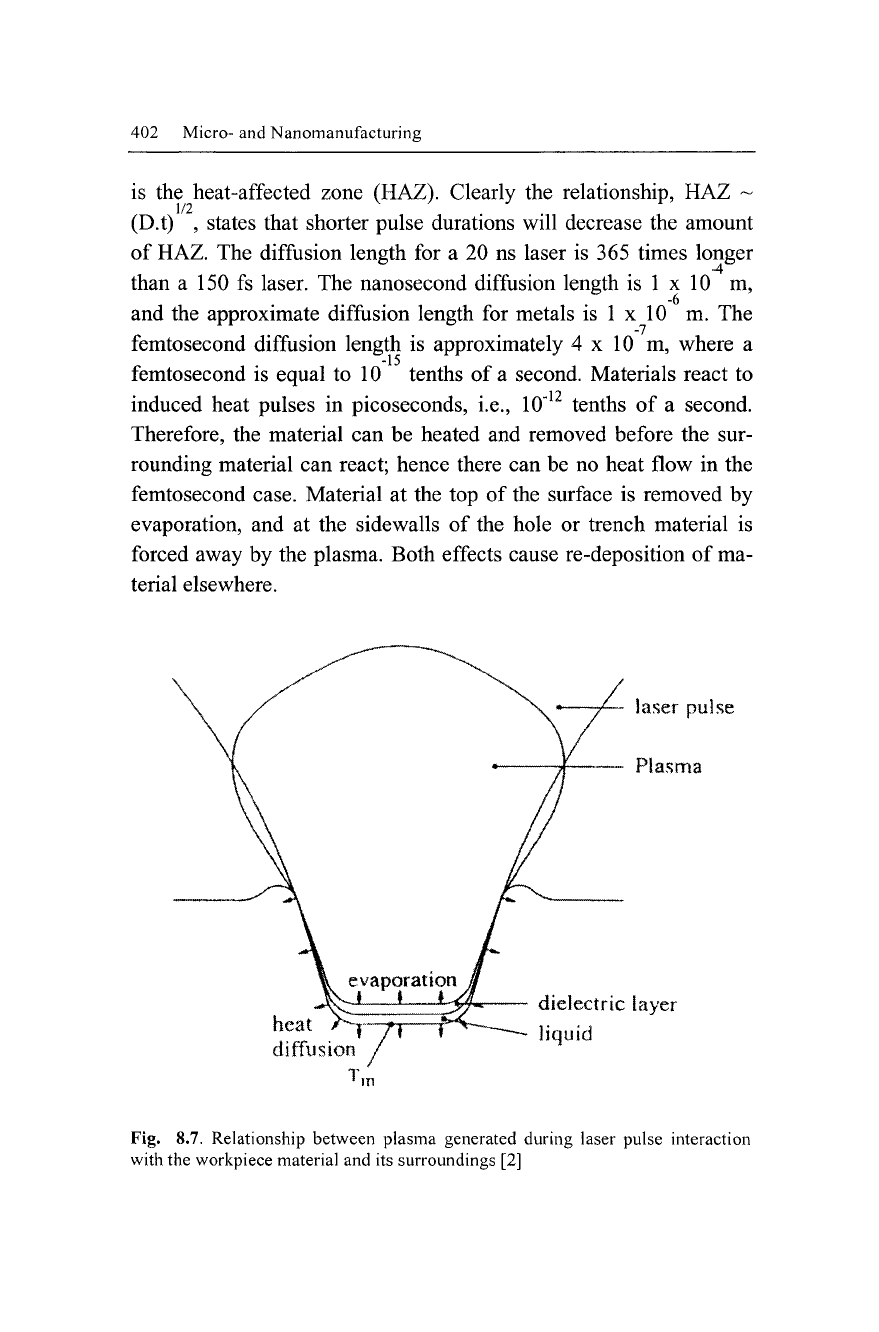
402 Micro- and Nanomanufacturing
is the heat-affected zone (HAZ). Clearly the relationship, HAZ -
(D.t) , states that shorter pulse durations will decrease the amount
of HAZ. The diffusion length for a 20 ns laser is 365 times longer
-4
than a 150 fs laser. The nanosecond diffusion length is 1 x 10 m,
and the approximate diffusion length for metals is 1 x 10 m. The
femtosecond diffusion length is approximately 4 x 10 m, where a
femtosecond is equal to 10 tenths of a second. Materials react to
induced heat pulses in picoseconds, i.e., 10"^^ tenths of a second.
Therefore, the material can be heated and removed before the sur-
rounding material can react; hence there can be no heat flow in the
femtosecond case. Material at the top of the surface is removed by
evaporation, and at the sidewalls of the hole or trench material is
forced away by the plasma. Both effects cause re-deposition of ma-
terial elsewhere.
diffusion
T
dielectric layer
liquid
Fig. 8.7. Relationship between plasma generated during laser pulse interaction
with the workpiece material and its surroundings [2]
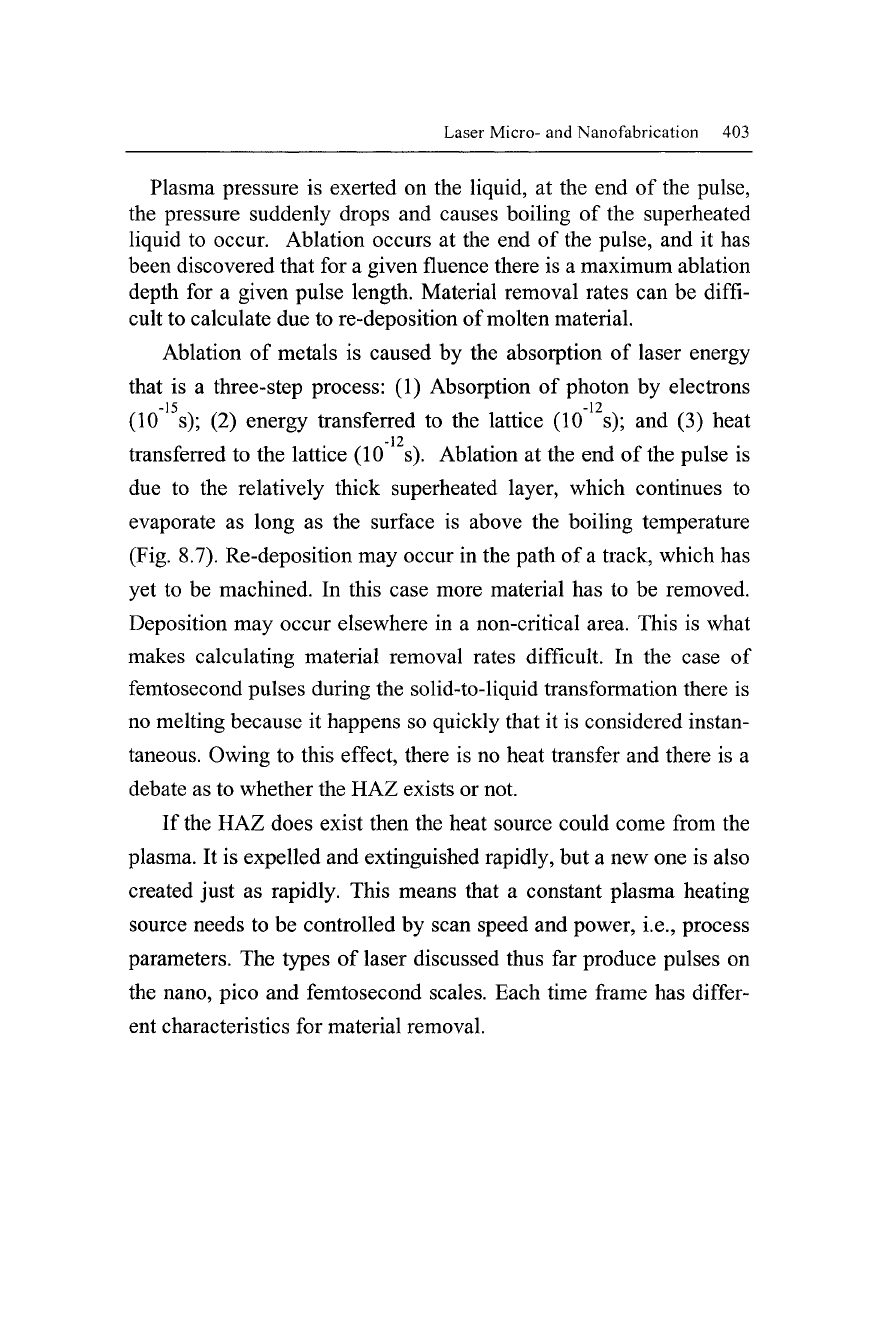
Laser Micro- and Nanofabrication 403
Plasma pressure is exerted on the liquid, at the end of the pulse,
the pressure suddenly drops and causes boiling of the superheated
liquid to occur. Ablation occurs at the end of the pulse, and it has
been discovered that for a given fluence there is a maximum ablation
depth for a given pulse length. Material removal rates can be diffi-
cult to calculate due to re-deposition of molten material.
Ablation of metals is caused by the absorption of laser energy
that is a three-step process: (1) Absorption of photon by electrons
-15 -12
(10 s); (2) energy transferred to the lattice (10 s); and (3) heat
-12
transferred to the lattice (10 s). Ablation at the end of the pulse is
due to the relatively thick superheated layer, which continues to
evaporate as long as the surface is above the boiling temperature
(Fig. 8.7). Re-deposition may occur in the path of a track, which has
yet to be machined. In this case more material has to be removed.
Deposition may occur elsewhere in a non-critical area. This is what
makes calculating material removal rates difficult. In the case of
femtosecond pulses during the solid-to-liquid transformation there is
no melting because it happens so quickly that it is considered instan-
taneous. Owing to this effect, there is no heat transfer and there is a
debate as to whether the HAZ exists or not.
If the HAZ does exist then the heat source could come from the
plasma. It is expelled and extinguished rapidly, but a new one is also
created just as rapidly. This means that a constant plasma heating
source needs to be controlled by scan speed and power, i.e., process
parameters. The types of laser discussed thus far produce pulses on
the nano, pico and femtosecond scales. Each time frame has differ-
ent characteristics for material removal.
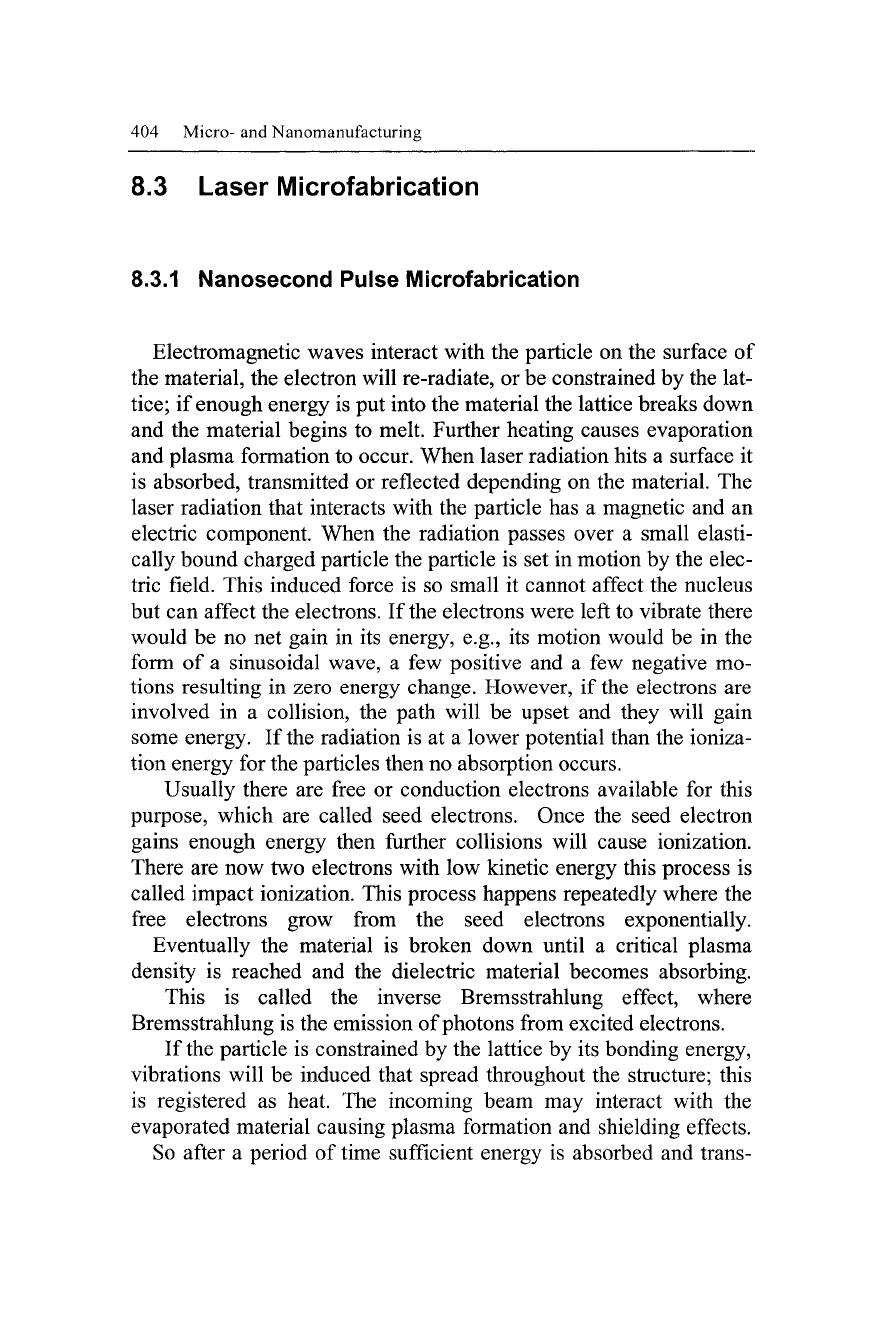
404 Micro-
and
Nanomanufacturing
8.3 Laser Microfabrication
8.3.1 Nanosecond Pulse Microfabrication
Electromagnetic waves interact with
the
particle
on the
surface
of
the material,
the
electron will re-radiate,
or
be constrained
by the
lat-
tice;
if
enough energy
is put
into
the
material
the
lattice breaks down
and
the
material begins
to
melt. Further heating causes evaporation
and plasma formation
to
occur. When laser radiation hits
a
surface
it
is absorbed, transmitted
or
reflected depending
on the
material.
The
laser radiation that interacts with
the
particle
has a
magnetic
and an
electric component. When
the
radiation passes over
a
small elasti-
cally bound charged particle
the
particle
is set in
motion
by the
elec-
tric field. This induced force
is so
small
it
cannot affect
the
nucleus
but
can
affect
the
electrons.
If
the electrons were left
to
vibrate there
would
be no net
gain
in its
energy,
e.g., its
motion would
be in the
form
of a
sinusoidal wave,
a few
positive
and a few
negative
mo-
tions resulting
in
zero energy change. However,
if
the electrons
are
involved
in a
collision,
the
path will
be
upset
and
they will gain
some energy.
If
the radiation
is at a
lower potential than
the
ioniza-
tion energy
for
the particles then
no
absorption occurs.
Usually there
are
free
or
conduction electrons available
for
this
purpose, which
are
called seed electrons. Once
the
seed electron
gains enough energy then further collisions will cause ionization.
There
are now two
electrons with
low
kinetic energy this process
is
called impact ionization. This process happens repeatedly where
the
free electrons grow from
the
seed electrons exponentially.
Eventually
the
material
is
broken down until
a
critical plasma
density
is
reached
and the
dielectric material becomes absorbing.
This
is
called
the
inverse Bremsstrahlung effect, where
Bremsstrahlung
is the
emission of photons from excited electrons.
If the particle
is
constrained
by the
lattice
by its
bonding energy,
vibrations will
be
induced that spread throughout
the
structure; this
is registered
as
heat.
The
incoming beam
may
interact with
the
evaporated material causing plasma formation
and
shielding effects.
So after
a
period
of
time sufficient energy
is
absorbed
and
trans-
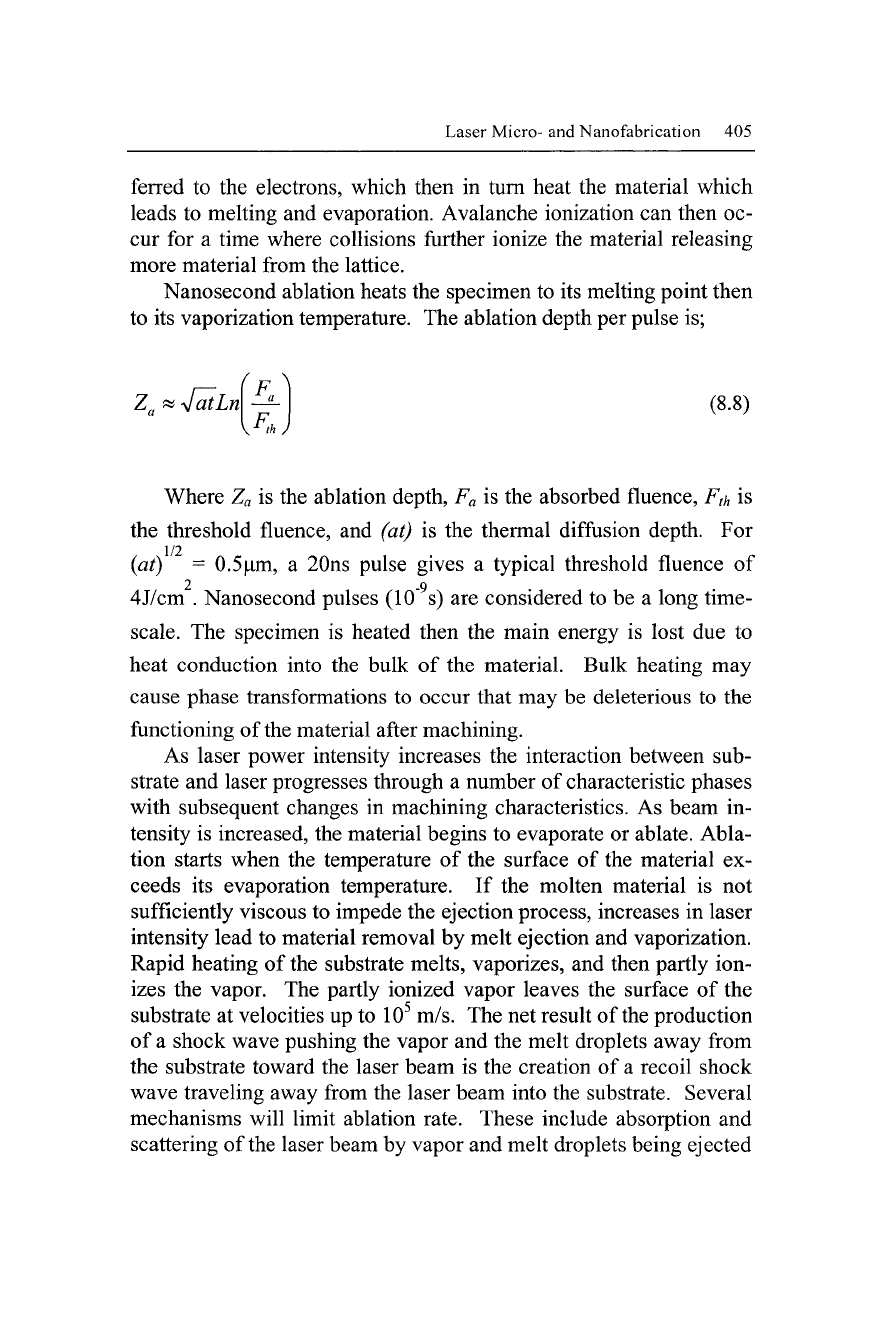
Laser Micro- and Nanofabrication 405
ferred to the electrons, which then in turn heat the material which
leads to melting and evaporation. Avalanche ionization can then oc-
cur for a time where collisions further ionize the material releasing
more material from the lattice.
Nanosecond ablation heats the specimen to its melting point then
to its vaporization temperature. The ablation depth per pulse is;
4atLn\
^F,,^
. F .
(8.8)
Where Z« is the ablation depth, Fa is the absorbed fluence,
Fth
is
the threshold fluence, and (at) is the thermal diffusion depth. For
1/2
{at) = 0.5|um, a 20ns pulse gives a typical threshold fluence of
4J/cm . Nanosecond pulses (10" s) are considered to be a long time-
scale. The specimen is heated then the main energy is lost due to
heat conduction into the bulk of the material. Bulk heating may
cause phase transformations to occur that may be deleterious to the
functioning of the material after machining.
As laser power intensity increases the interaction between sub-
strate and laser progresses through a number of characteristic phases
with subsequent changes in machining characteristics. As beam in-
tensity is increased, the material begins to evaporate or ablate. Abla-
tion starts when the temperature of the surface of the material ex-
ceeds its evaporation temperature. If the molten material is not
sufficiently viscous to impede the ejection process, increases in laser
intensity lead to material removal by melt ejection and vaporization.
Rapid heating of the substrate melts, vaporizes, and then partly ion-
izes the vapor. The partly ionized vapor leaves the surface of the
substrate at velocities up to 10^ m/s. The net result of the production
of a shock wave pushing the vapor and the melt droplets away from
the substrate toward the laser beam is the creation of a recoil shock
wave traveling away from the laser beam into the substrate. Several
mechanisms will limit ablation rate. These include absorption and
scattering of
the
laser beam by vapor and melt droplets being ejected
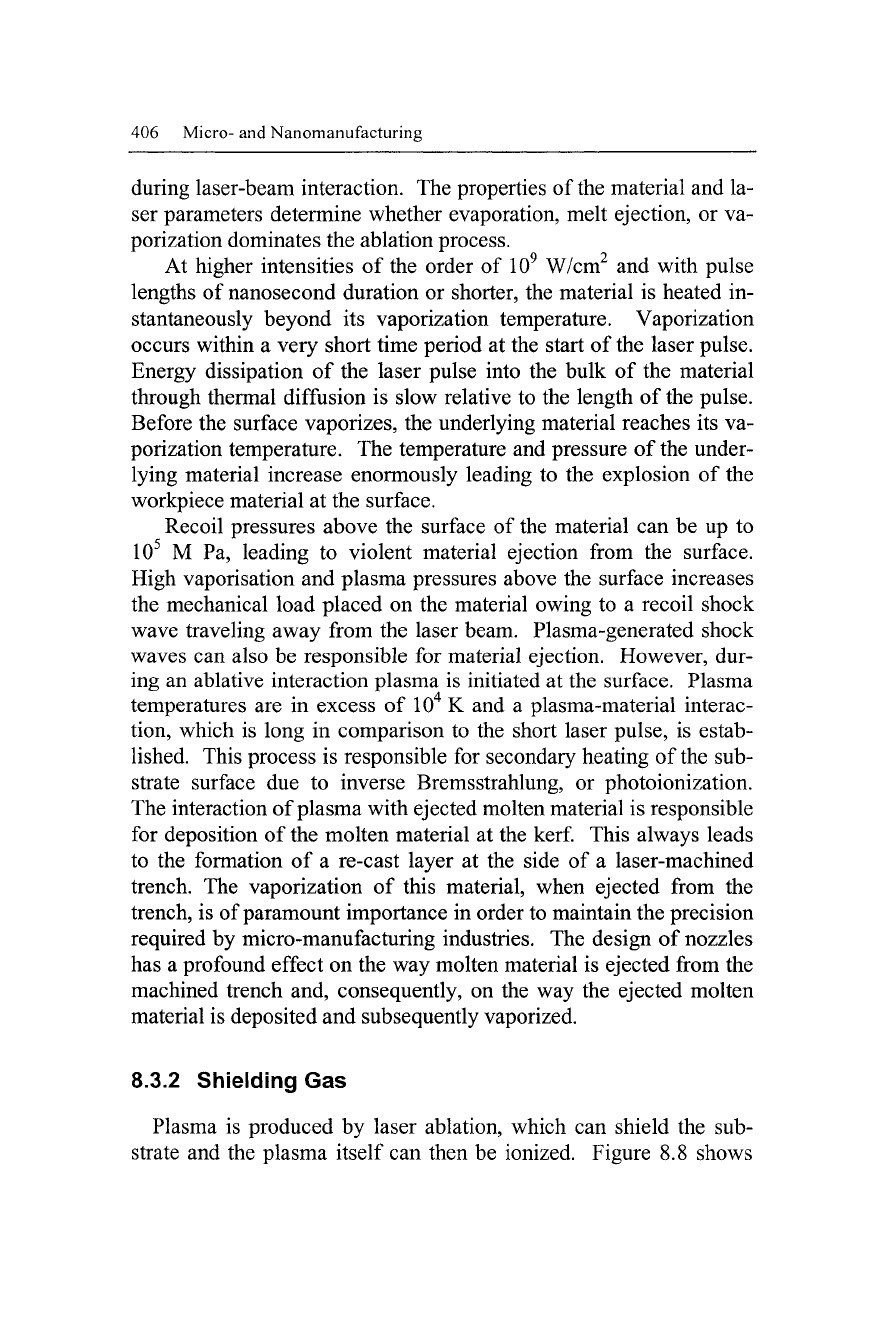
406 Micro- and Nanomanufacturing
during laser-beam interaction. The properties of the material and la-
ser parameters determine whether evaporation, melt ejection, or va-
porization dominates the ablation process.
At higher intensities of the order of 10^ W/cm^ and with pulse
lengths of nanosecond duration or shorter, the material is heated in-
stantaneously beyond its vaporization temperature. Vaporization
occurs within a very short time period at the start of the laser pulse.
Energy dissipation of the laser pulse into the bulk of the material
through thermal diffusion is slow relative to the length of the pulse.
Before the surface vaporizes, the underlying material reaches its va-
porization temperature. The temperature and pressure of the under-
lying material increase enormously leading to the explosion of the
workpiece material at the surface.
Recoil pressures above the surface of the material can be up to
10^
M Pa, leading to violent material ejection from the surface.
High vaporisation and plasma pressures above the surface increases
the mechanical load placed on the material owing to a recoil shock
wave traveling away from the laser beam. Plasma-generated shock
waves can also be responsible for material ejection. However, dur-
ing an ablative interaction plasma is initiated at the surface. Plasma
temperatures are in excess of 10^ K and a plasma-material interac-
tion, which is long in comparison to the short laser pulse, is estab-
lished. This process is responsible for secondary heating of the sub-
strate surface due to inverse Bremsstrahlung, or photoionization.
The interaction of plasma with ejected molten material is responsible
for deposition of the molten material at the kerf This always leads
to the formation of a re-cast layer at the side of a laser-machined
trench. The vaporization of this material, when ejected from the
trench, is of paramount importance in order to maintain the precision
required by micro-manufacturing industries. The design of nozzles
has a profound effect on the way molten material is ejected from the
machined trench and, consequently, on the way the ejected molten
material is deposited and subsequently vaporized.
8.3.2 Shielding Gas
Plasma is produced by laser ablation, which can shield the sub-
strate and the plasma itself can then be ionized. Figure 8.8 shows
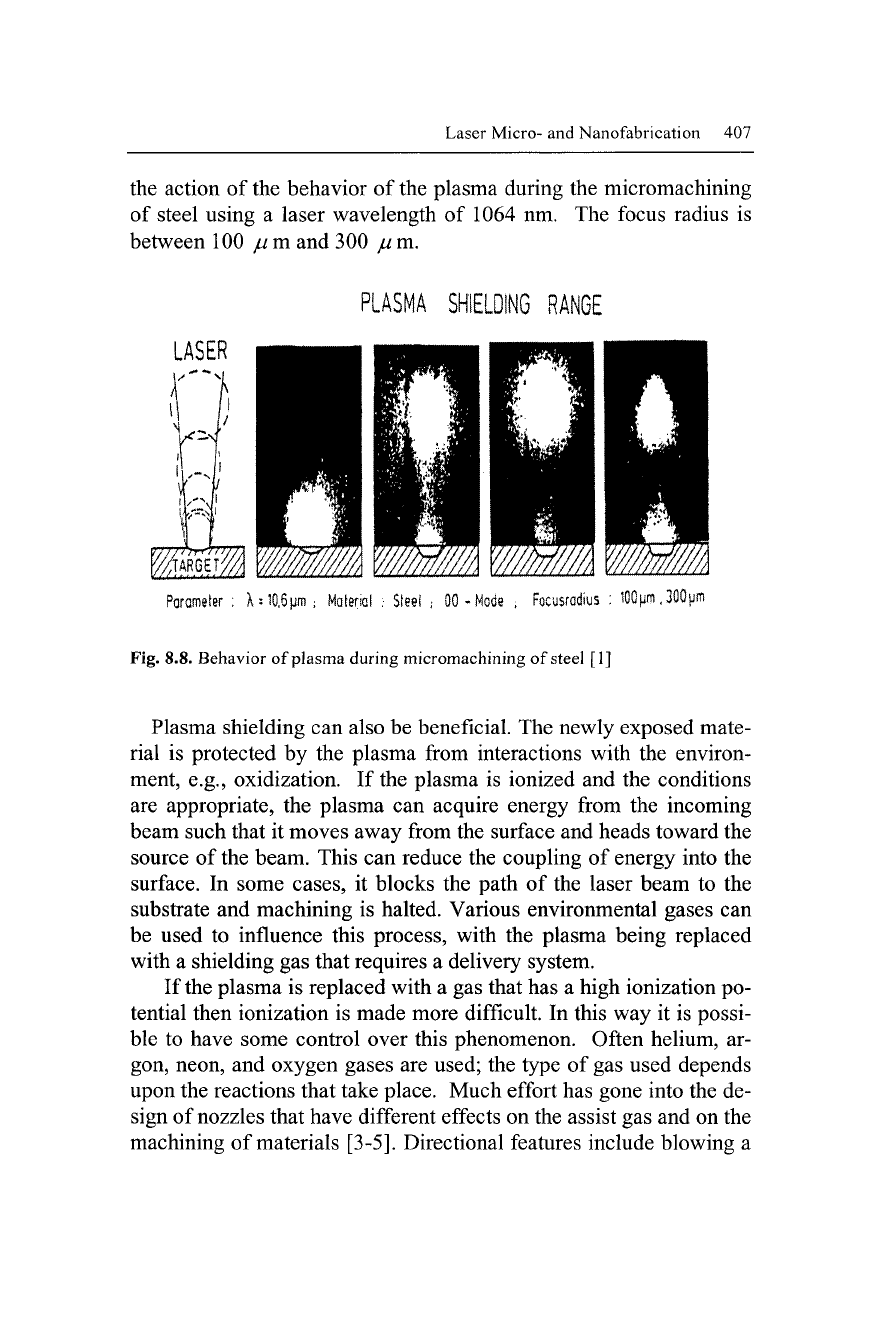
Laser Micro- and Nanofabrication 407
the action of the behavior of the plasma during the micromachining
of steel using a laser wavelength of 1064 nm. The focus radius is
between 100 jum and 300 jum.
PLASMA SHIELDING RANGE
Parameier
;
X:10.6pm; MaleriGl
:•
Sfeel
;
00-Node
;
Focusrodius
:
lOC|im.300|jiT]
Fig. 8.8. Behavior of plasma during micromachining of steel [1]
Plasma shielding can also be beneficial. The newly exposed mate-
rial is protected by the plasma from interactions with the environ-
ment, e.g., oxidization. If the plasma is ionized and the conditions
are appropriate, the plasma can acquire energy from the incoming
beam such that it moves away from the surface and heads toward the
source of the beam. This can reduce the coupling of energy into the
surface. In some cases, it blocks the path of the laser beam to the
substrate and machining is halted. Various environmental gases can
be used to influence this process, with the plasma being replaced
with a shielding gas that requires a delivery system.
If the plasma is replaced with a gas that has a high ionization po-
tential then ionization is made more difficult. In this way it is possi-
ble to have some control over this phenomenon. Often helium, ar-
gon, neon, and oxygen gases are used; the type of gas used depends
upon the reactions that take place. Much effort has gone into the de-
sign of nozzles that have different effects on the assist gas and on the
machining of materials
[3-5].
Directional features include blowing a
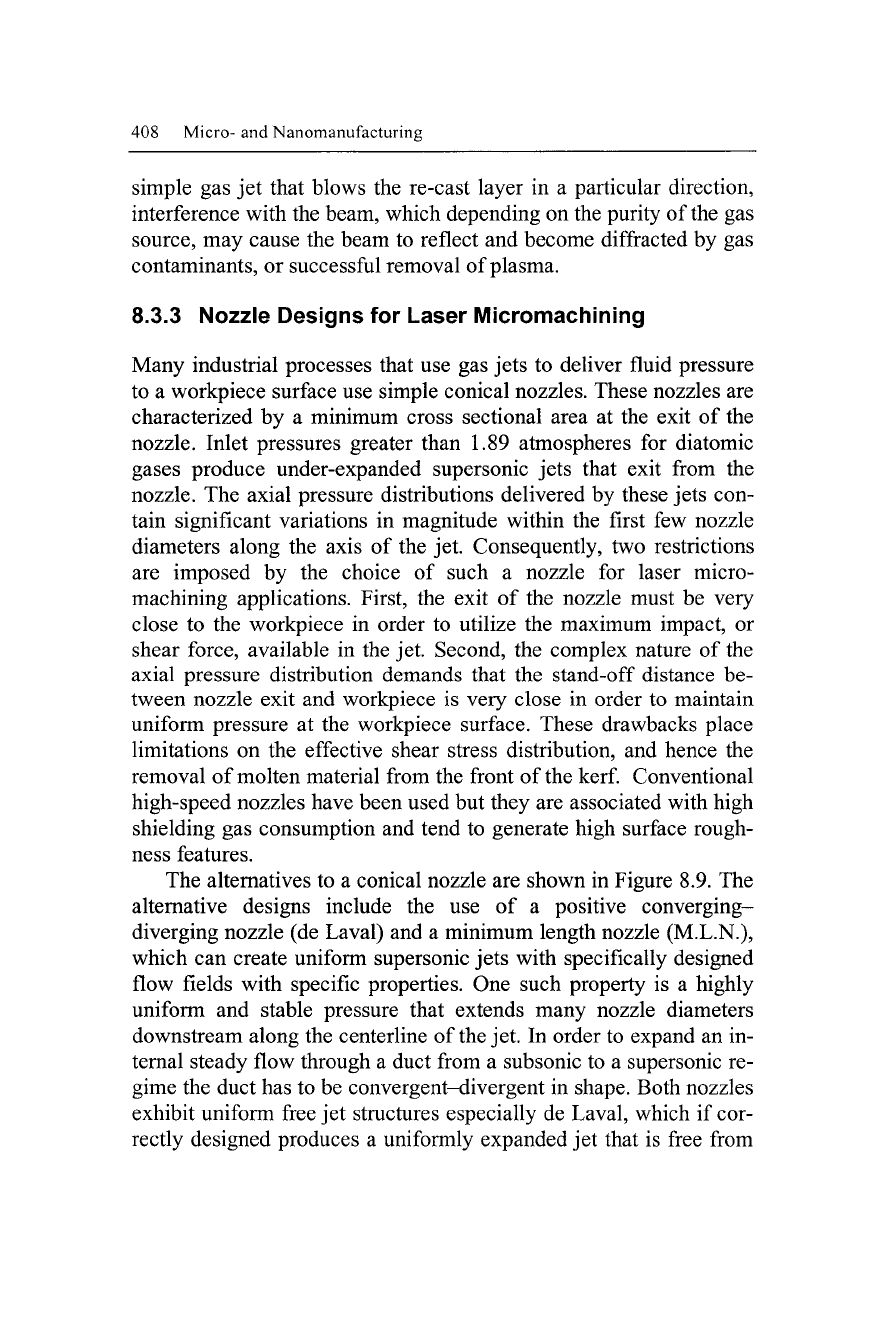
408 Micro- and Nanomanufacturing
simple gas jet that blows the re-cast layer in a particular direction,
interference with the beam, which depending on the purity of
the
gas
source, may cause the beam to reflect and become diffracted by gas
contaminants, or successful removal of plasma.
8.3.3 Nozzle Designs for Laser Micromachining
Many industrial processes that use gas jets to deliver fluid pressure
to a workpiece surface use simple conical nozzles. These nozzles are
characterized by a minimum cross sectional area at the exit of the
nozzle. Inlet pressures greater than 1.89 atmospheres for diatomic
gases produce under-expanded supersonic jets that exit from the
nozzle. The axial pressure distributions delivered by these jets con-
tain significant variations in magnitude within the first few nozzle
diameters along the axis of the jet. Consequently, two restrictions
are imposed by the choice of such a nozzle for laser micro-
machining applications. First, the exit of the nozzle must be very
close to the workpiece in order to utilize the maximum impact, or
shear force, available in the jet. Second, the complex nature of the
axial pressure distribution demands that the stand-off distance be-
tween nozzle exit and workpiece is very close in order to maintain
uniform pressure at the workpiece surface. These drawbacks place
limitations on the effective shear stress distribution, and hence the
removal of molten material from the front of the kerf Conventional
high-speed nozzles have been used but they are associated with high
shielding gas consumption and tend to generate high surface rough-
ness features.
The alternatives to a conical nozzle are shown in Figure 8.9. The
alternative designs include the use of a positive converging-
diverging nozzle (de Laval) and a minimum length nozzle (M.L.N.),
which can create uniform supersonic jets with specifically designed
flow fields with specific properties. One such property is a highly
uniform and stable pressure that extends many nozzle diameters
downstream along the centerline of the jet. In order to expand an in-
ternal steady flow through a duct from a subsonic to a supersonic re-
gime the duct has to be convergent-divergent in shape. Both nozzles
exhibit uniform free jet structures especially de Laval, which if cor-
rectly designed produces a uniformly expanded jet that is free from
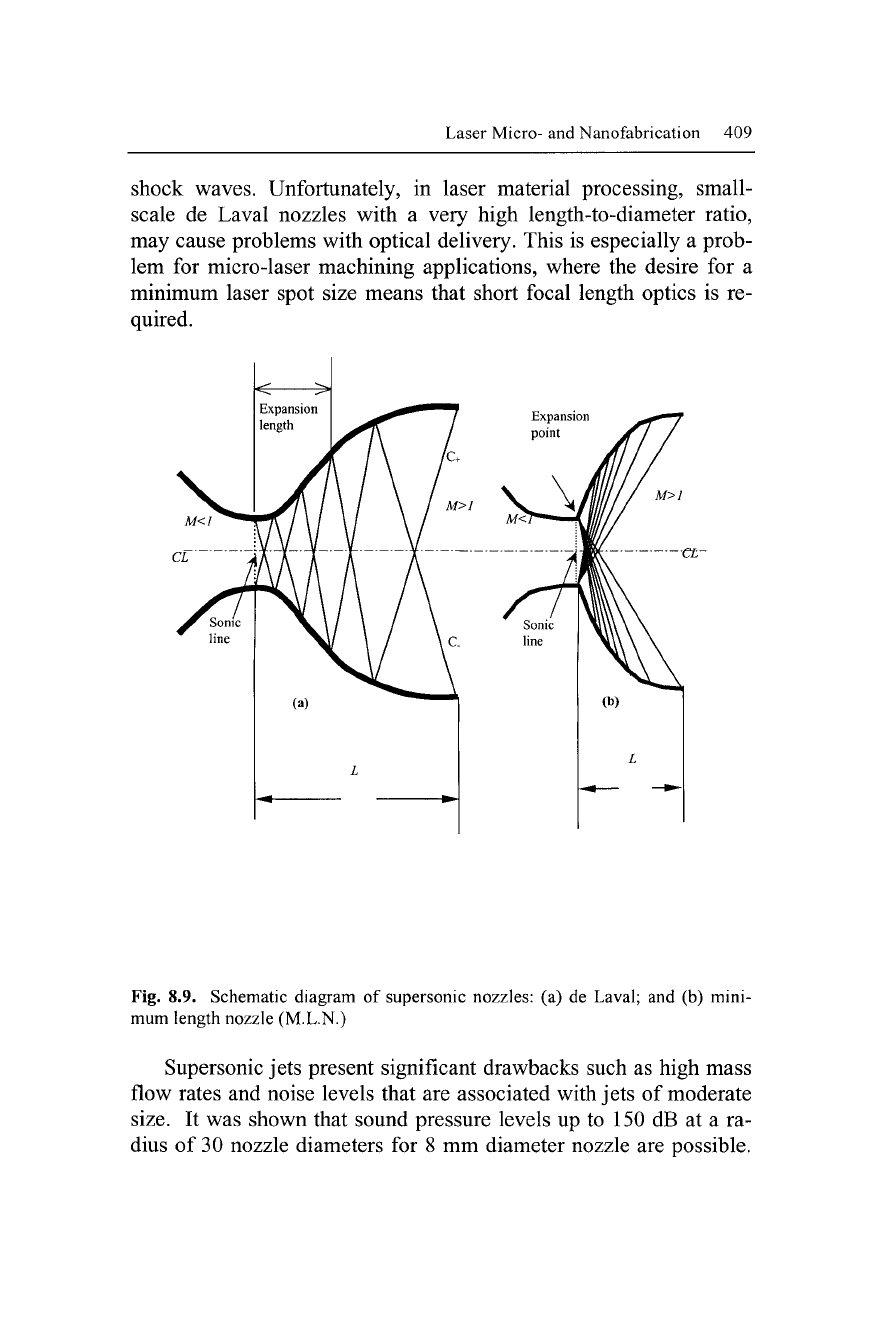
Laser Micro- and Nanofabrication 409
shock waves. Unfortunately, in laser material processing, small-
scale de Laval nozzles with a very high length-to-diameter ratio,
may cause problems with optical delivery. This is especially a prob-
lem for micro-laser machining applications, where the desire for a
minimum laser spot size means that short focal length optics is re-
quired.
Expansion
point
M>1
Fig. 8.9. Schematic diagram of supersonic nozzles: (a) de Laval; and (b) mini-
mum length nozzle (M.L.N.)
Supersonic jets present significant drawbacks such as high mass
flow rates and noise levels that are associated with jets of moderate
size.
It was shown that sound pressure levels up to 150 dB at a ra-
dius of 30 nozzle diameters for 8 mm diameter nozzle are possible.
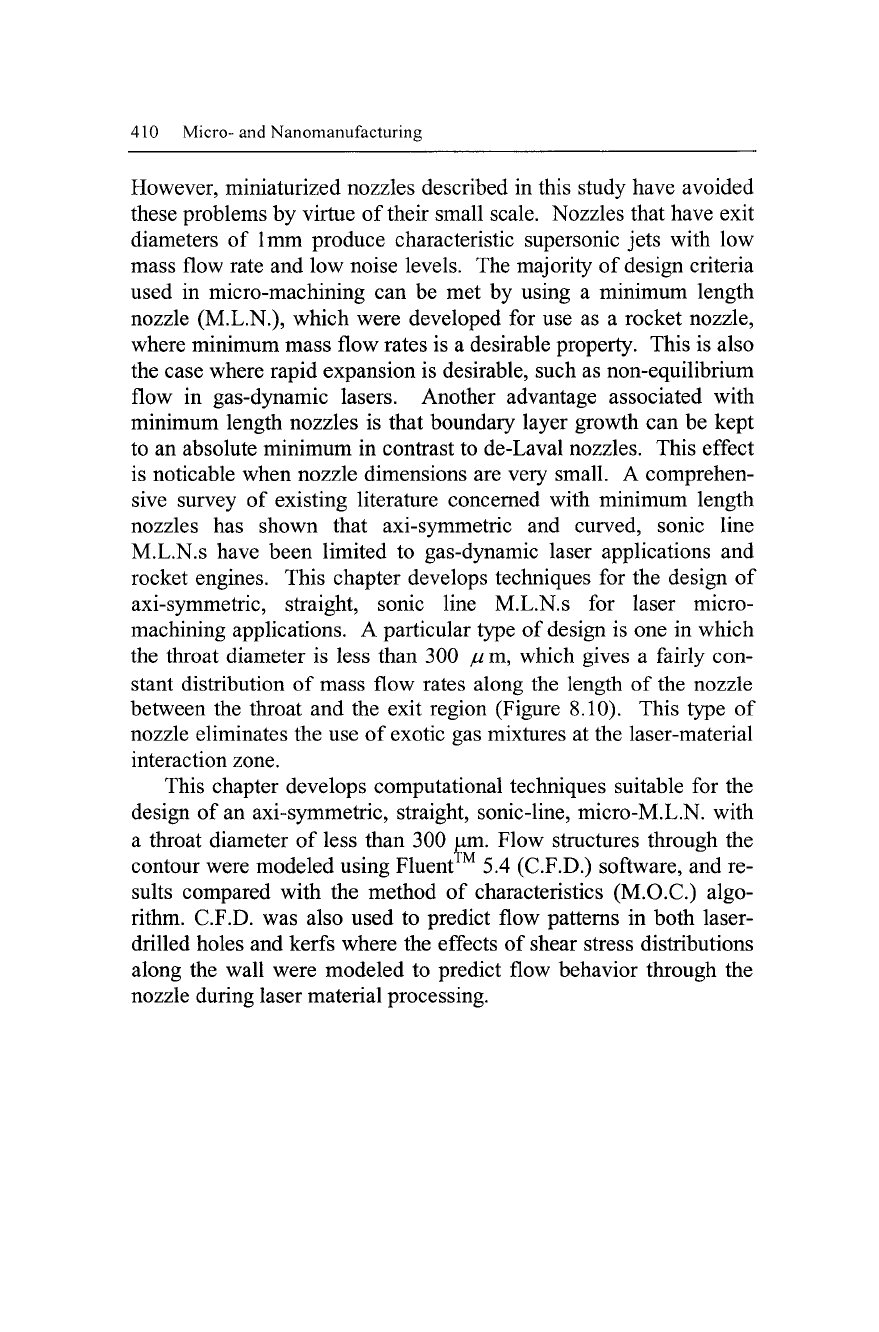
410 Micro-and Nanomanufacturing
However, miniaturized nozzles described in this study have avoided
these problems by virtue of their small scale. Nozzles that have exit
diameters of 1mm produce characteristic supersonic jets with low
mass flow rate and low noise levels. The majority of design criteria
used in micro-machining can be met by using a minimum length
nozzle (M.L.N.), which were developed for use as a rocket nozzle,
where minimum mass flow rates is a desirable property. This is also
the case where rapid expansion is desirable, such as non-equilibrium
flow in gas-dynamic lasers. Another advantage associated with
minimum length nozzles is that boundary layer growth can be kept
to an absolute minimum in contrast to de-Laval nozzles. This effect
is noticable when nozzle dimensions are very small. A comprehen-
sive survey of existing literature concerned with minimum length
nozzles has shown that axi-symmetric and curved, sonic line
M.L.N.s have been limited to gas-dynamic laser applications and
rocket engines. This chapter develops techniques for the design of
axi-symmetric, straight, sonic line M.L.N.s for laser micro-
machining applications. A particular type of design is one in which
the throat diameter is less than 300 // m, which gives a fairly con-
stant distribution of mass flow rates along the length of the nozzle
between the throat and the exit region (Figure 8.10). This type of
nozzle eliminates the use of exotic gas mixtures at the laser-material
interaction zone.
This chapter develops computational techniques suitable for the
design of an axi-symmetric, straight, sonic-line, micro-M.L.N. with
a throat diameter of less than 300 um. Flow structures through the
contour were modeled using Fluent ^5.4 (C.F.D.) software, and re-
sults compared with the method of characteristics (M.O.C.) algo-
rithm. C.F.D. was also used to predict flow patterns in both laser-
drilled holes and kerfs where the effects of shear stress distributions
along the wall were modeled to predict flow behavior through the
nozzle during laser material processing.
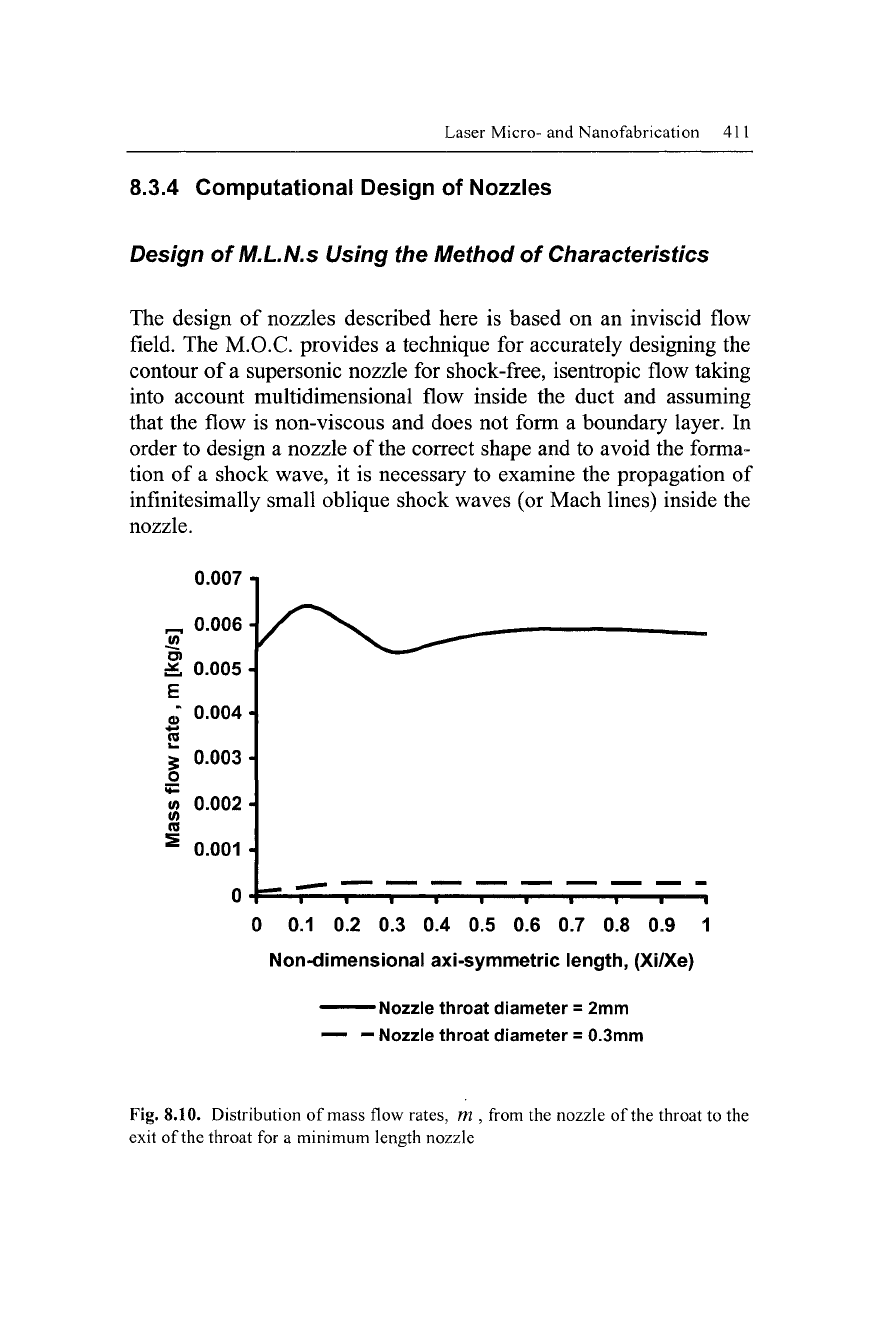
Laser Micro-
and
Nanofabrication
411
8.3.4 Computational Design of Nozzles
Design
ofM.L.N.s
Using ttie Mettiod
of
Characteristics
The design
of
nozzles described here
is
based
on an
inviscid flow
field.
The
M.O.C. provides
a
technique
for
accurately designing
the
contour
of
a supersonic nozzle
for
shock-free, isentropic flow taking
into account multidimensional flow inside
the
duct
and
assuming
that
the
flow
is
non-viscous
and
does
not
form
a
boundary layer.
In
order
to
design
a
nozzle
of
the correct shape
and to
avoid
the
forma-
tion
of a
shock wave,
it is
necessary
to
examine
the
propagation
of
infinitesimally small oblique shock waves
(or
Mach lines) inside
the
nozzle.
0.007
1
E
1
0)
(0
0.006
A
0.005
J
0.004
A
0.003
J
0.002
A
0.001
A
I
I I I I I I I I I
0
0.1 0.2 0.3 0.4 0.5 0.6 0.7 0.8 0.9 1
Non-dimensional axi-symmetric length, (Xi/Xe)
Nozzle throat diameter
=
2mm
—
—
Nozzle throat diameter
=
0.3mm
Fig. 8.10. Distribution
of
mass flow rates,
m ,
from
the
nozzle
of
the throat
to the
exit of the throat
for a
minimum length nozzle
